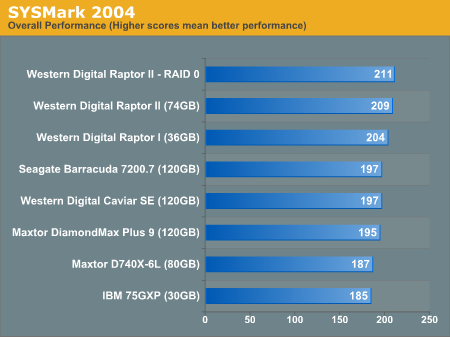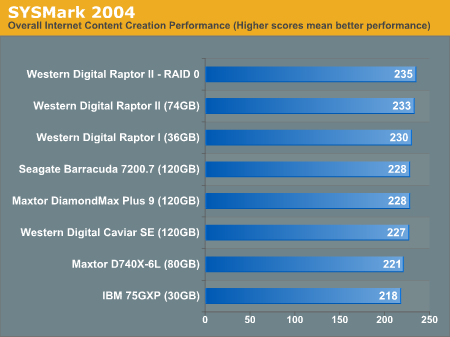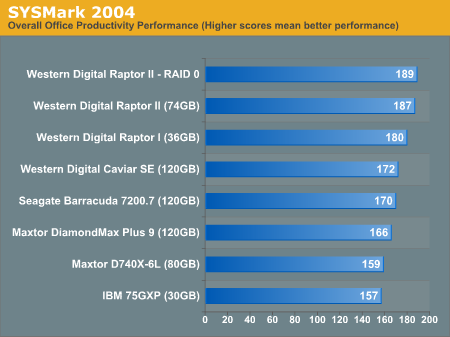Western Digital's Raptors in RAID-0: Are two drives better than one?
by Anand Lal Shimpi on July 1, 2004 12:00 PM EST- Posted in
- Storage
SYSMark Performance Summary
The overall SYSMark scores summarize what we've seen thus far:
The overall SYSMark performance graph pretty much says it all - a slight, but completely unnoticeable, performance increase, thanks to RAID-0, is what buying a second drive will get you.
As a recap, here's what happens with the Internet Content Creation suite:
"In this scenario, the content creator creates a product-related website targeting a broadband and narrowband audience. The user first renders a 3D model to a bitmap, while preparing web pages using a web site publishing tool. The user opens a video editing package, creates a movie from several raw input movie cuts and sound cuts and starts exporting it. While waiting on this operation, the user imports the rendered image into an image-processing package, modifies it and saves the results. Back in the 3D modeling software, the user modifies a 3D model and exports it to a vector-graphics format. Once the movie is assembled, the user edits it and creates special effects using one of the modified images as input. The user extracts content from an archive. Meanwhile, he uses an animation creation tool to open the exported 3D vector graphics file. He modifies it by including other pictures and optimizes it for faster animation. The final movie with the special effects is then compressed in a format that can be broadcast over broadband Internet. The web site is given the final touches and the system is scanned for viruses."

The trend continues with overall Internet Content Creation performance.
Also recapping, here's what happens in the entire Office Productivity suite:
"In this scenario, the office productivity user creates a marketing presentation and supporting documents for a new product. The user receives email containing a collection of documents in a compressed file. The user reviews his email and updates his calendar while a virus checking software scans the system. The corporate web site is viewed and the user begins creating the collateral documents. The user also accesses a database and runs some queries. A collection of documents are compressed. The queries' results are imported into a spreadsheet and used to generate graphical charts. The user then transcribes a document. Once the document has all the necessary pieces in place, the user changes it into a portable format for easy and secure distribution. The user edits and adds elements to a slide show template. Finally, the user looks at the results of his work (both the slide show and the portable document) in an Internet browser."

Even in our office productivity tests, we see that RAID-0 basically yields no performance improvement.










127 Comments
View All Comments
RDMustang1 - Thursday, July 1, 2004 - link
AMDScooter is right on. Onboard RAID (and most cheap raid cards such as Promise) are technically software RAID cards and usually do not offer any speed increases over 5%. True hardware RAID cards offer speed increases at about 40% (as shown in the past). This varies of course with the implementation but on average hardware RAID has been shown to increase performance much more than these cheap RAID impelementations. Regs needs to look into what he's talking about more because performance advantages are not lost in advertising.pio!pio! - Thursday, July 1, 2004 - link
I do a some video editing and I'm wondering the performance gain of say reading a a 4GB file and writing directly writing it again (ie a copy) in a RAID or non raid configuration. I'm using a single HDD right now, but I'm thinking of going to 2 HDD and read from one HDD and copy to the other..but I'm wondering if a RAID configuration will offer similar advantages?mkruer - Thursday, July 1, 2004 - link
I am building my self a new system this year, and I am seriously thinking of getting 2x250 Western Digital Caviars (SATA) and making them into a RAID 1, for redundancy purposes. I already knew that RAID 0 offers little real world improvements, but I would like to see how it compares to RAID 0 and just a single drive. I have never under stood why you bother comparing 8 normal drive, and one of them in RAID 0.Why not rerun the tests with just a single type of drive, one standard (stand alone), one RAID 0 and one RAID 1. All things being equal this should give a better indication of just how well any drives should do in the following configurations, using that RAID chip. (Yes there will be some small differences, but the should end up being negligible)
I would recommend choosing your favorite three drives, and doing a comparison of each RAID version on that.
eastvillager - Thursday, July 1, 2004 - link
Ok, you kind of lost me when you didn't install the Intel Application Accelerator...AMDScooter - Thursday, July 1, 2004 - link
I hope this does not come off as a bash as the review was informative to some extent, but I feel it is lacking in several areas. Why bother to waste space describing in detail the differences between RAID 1 & 0 if no benchmarks from a RAID 1 are going to be included in the article?? And as mentioned earlier, using only a single onboard RAID soloution has some merit for parity in benchmarking but is hardly definitive. This would have been a more well rounded review just by adding adding some RAID 1 benchmarks along with benchmarks from different RAID IDE/SATA controllers AND the differences in CPU utilization between them. Most of the onboard soloutions are actually SOFTWARE RAID's as compared to a true dedicated hardware device. It would also have been nice to see some SCSI RAID benchies tossed in the mix. SATA drives are almost in the same price as entry level 15k rpm SCSI U320 drives. While SCSI RAID is not on any normal desktop MOBO's, many users purchase seperate RAID cards anyway. I use 2 Seagate 15k.3's in RAID0 on a Adaptec 39320 Host RAID device. It sure feels faster than a single drive to me ;)MrMoo - Thursday, July 1, 2004 - link
This article and previous raid related ones ive read here have all seemed to be opposite of results ive seen with my setup. I have a Promise TX2000 raid controller and four IBM/Hitachi 180GB 7200rpm drives.Originally i only had one of the hitachis and when i went to a 2 drive raid 0 the perfomance increase was definitely noticeable. I wont bother repeating any benchmarks i have of it because i dont feel they really tell anything, nor do i still have ay records of them. But most places i could see noticeable improvements were in application loads, game loads and most signicantly when windows would boot up, especially once the windows install had become old and lots of apps were all trying to load at the same time.
Then last fall i purchased another 2 hitachi drives and decided to test out a 4 disk raid 0 Now did that thing fly, application loads were almost instantanious for all but the largest programs. and my performance was limited almost entirely by the PCI bus (oh how i hate thee) as i was acheiving average transfer rates of 120 MB/s as reported by sandra and HdTach.
Then recently (yesterday to be exact) I purchased 2 SATA Hitachi 250GB drives and i hooked them up as raid 0 on my onboard sata raid controller (a Silicon Image 3112 controller on my Albatron KX18D) here i would acheive about 65 MB/s transfer rates. this seems on par with was i would expect, but then i notice that cpu usage with the sata raid was around 55% and it was only about 5% with the promise IDE raid.
Even though the average transfer rate of the new array are greater than one drive, performance with programs running off of it dont seem any faster than a single drive.
My only thought is whether these onboard raid solutions use up so much overheard that the performance increase is negligable. all my experience with them seems to say raid 0 on them is useless, but raid 0 on a dedicated controller seems to increase performance drastically.
Regs - Thursday, July 1, 2004 - link
*what*Regs - Thursday, July 1, 2004 - link
I doubt a better raid card will offer any more performance. Maybe another 1-2%. 2% is was seperates quality these days in advertising.ep0ch - Thursday, July 1, 2004 - link
I usually like your articles Anand. But the one really fundamental thing wrong with the whole comparison is that you didn't actually compare RAID0 with a decent RAID 0 card like HighPoint RocketRAID.Insomniac - Thursday, July 1, 2004 - link
I just realized performance is only as fast as the slowest drive. So pairing a Raptor up with a cheap 80 GB drive is a waste.